• Dahabiya Nile Sailing •
Short Description: This tour covers the highlights of Egypt in Cairo, Luxor, and Aswan, as well as some sites rarely visited by tourists. The highlight of this tour is sailing the Nile in comfort on board a traditional sailing boat called the Dahabiya, as the Ancient Egyptians did thousands of years ago.
*The preferred day to start this tour is Friday, but we can organize other departure dates for 3+ cabins.
*All our guides have a background in Egyptology, history, archeology and guiding. They are all officially licensed guides.
Day 1
Visit Saqqara. Include the Step pyramid and the Nobles tombs. Visit Dahshur. Include the bent pyramid and the Red pyramid. Lunch at Saqqara, a good place to try Egyptian food. Normally they serve mix grill, kofta, and lots of small dishes filled with appetizers.Visit Giza. Include the Great pyramid, The Sphinx, Khara pyramid, Menkawra pyramid, and priest Kar tomb. Camel ride. In the desert around Giza pyramids to the Sphinx for about 40 minutes.The tour duration 8-9 hours. Night stay in Cairo
Optional tours and activities

30 km (19 miles) from Cairo, Saqqara is an archaeological site that continues to reveal its treasures through new discoveries. The site covers 7 kilometres (4.4 miles) on the west bank of the Nile. Saqqara, best known for its step pyramids, was the necropolis of the Egyptian capital, Memphis. Buried here were people as well as many sacred animals. Construction here continued from 3,050 BC with 1st Dynasty funerary structures to 6th century AD Coptic monasteries. The highlights of the site are the step pyramid (pyramid of Djoser), pyramid of Unas, and the Nobles tombs. Other sites may be visited depending on time and availability, such as the Serapeum and Imhotep Museum.
10 km (6 miles) south of Saqqara, we visit Dahshur, which shows the change from the step pyramid method of construction to the true pyramid shape. Two of the pyramids here are among the oldest, largest, and best preserved in Egypt. These were commissioned by 4th Dynasty King Snefru (2649–2609 BC). Highlights of the site include the bent pyramid, the red pyramid, which is second in size only to the great Giza Pyramid, and other pyramids. Lunch at Saqqara is a good place to try Egyptian food.
The Giza pyramids are the only survivor of the Seven Wonders of the Ancient World; more than 4,000 years after their construction, they still leave visitors in a state of fascinated awe. The Great Pyramid of Khufu (2609–2584 BC) is the largest pyramid in Egypt and the world and the oldest of the Giza pyramids, standing 138 metres (453 feet) high. We also see the pyramids of Khafre and Menkaure and the pyramids of the Queens. Entering the Great Pyramid is an option and a memorable experience; however, this is not recommended if you experience claustrophobia or are not in good health. The interiors of the pyramids are not decorated but are noteworthy for the advanced engineering involved in their construction. Other attractions include the tombs of the nobles, where we visit the tomb of the priest Kar, and the Sphinx and its temple. The Sphinx was carved from one piece of limestone and is 60 metres (197 feet) long and 20 metres (66 feet) wide.
A camel ride in the desert around the Giza pyramids leads to the Sphinx, about 40 minutes away.
Overnight in Cairo
Day 2
Visit the Egyptian museum. (Or the Grand Egyptian Museum when open) .Walking tour in Downtown Cairo. Lunch at Abo Tarek, famous for Koshri as the most common fast food in Egypt, mix of rice, pasta, little, check peas, fried onion, and tomato sauce.Visit Coptic/Old Cairo. Include the hanging church and Abu Serga Church.The tour duration 7-8 hours. Night stay in Cairo.
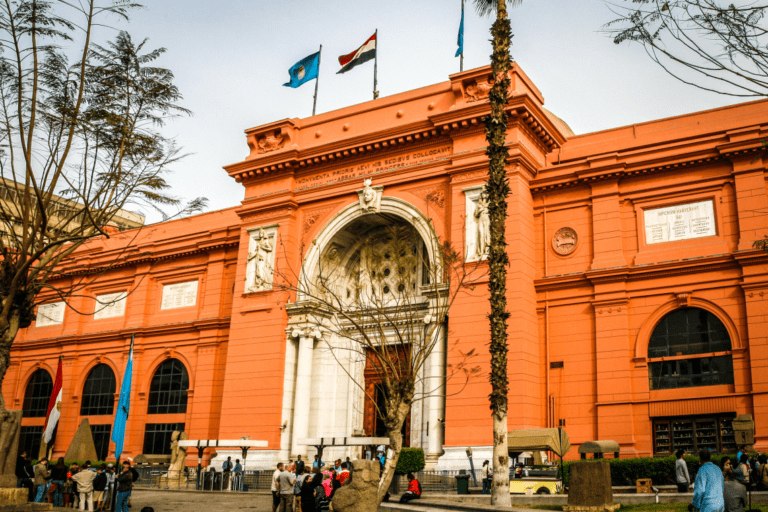
Visit the Egyptian Museum, including the King Tutankhamun collection and the Animal Mummies Room. OR visit the Grand Egyptian Museum, when it opens. The museum contains a vast collection of artefacts and gives you an understanding of the richness of the art and culture once situated at many of the sites you will visit elsewhere in Egypt.
We have a lunch at Abo Tarek restaurant, which is famous for koshari, the most common fast food in Egypt, a mix of rice, pasta, lentils, chickpeas, fried onions, and tomato sauce.
We end the day exploring Coptic. Old Cairo is the oldest area of Cairo and includes mosques, churches, synagogues, and a Roman fortress, with great diversity within one area. Highlights include the Hanging Church, the Abu Serga Church, and the Ben Ezra Synagogue.
Overnight stay in Cairo.
Day 3
Transfer to Cairo Airport and fly to Luxor. 1 hour flight. Visit the Valley of the Kings, Hatshepsut temple, and the Colossus of Memnon.The tour duration 4-5 hours.Lunch at a farmer’s house. A good chance to meet local people. The lunch includes a brief cookery lesson. You can replace this with lunch in a regular restaurant. Check-in for the hotel night stay in Luxor.
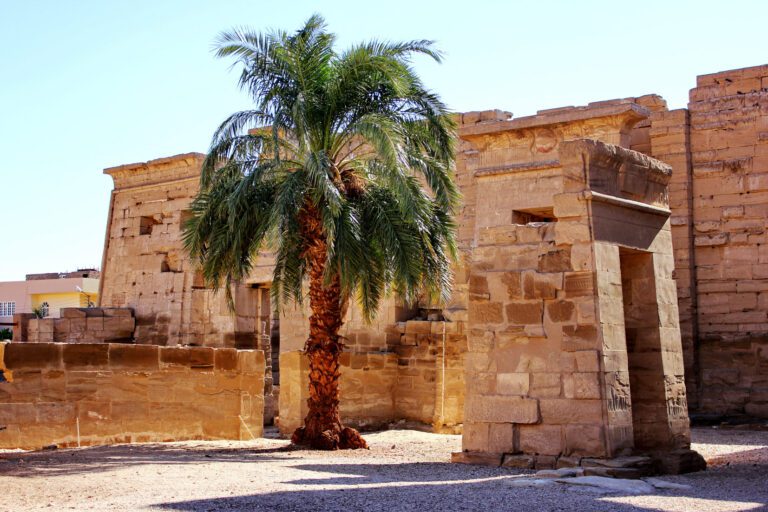
transfer to the airport, flight from Cairo to Luxor On the West Bank, our first stop is to see the
Colossi of Memnon. These two imposing sandstone statues indicate the site of the mortuary temple of 18th-dynasty pharaoh Amenhotep III (1386–1353 BC). 18 metres (59 feet) high, and each is estimated to weigh 653 t (720 tons). Visit the Valley of the Kings, where your
tour guide will lead you to the most important tombs among the currently open tombs in the valley. You visit 3 tombs of the more than 10 tombs that are currently open. Visit Hatshepsut temple. Lunch at a local farmer’s family house was an opportunity to experience life on the West Bank. This can be replaced with lunch at a restaurant on request.
Visit Deir El Medina as a unique attraction to learn about the lives of the local ancient Egyptians. Here, the workers who founded the Valley of the Kings, Queens, and Other Masterpieces in Luxor’s West Bank lived and were buried from the beginning of the New
Kingdom (1569 BC).
Visit Medinat Habu (Habu Temple), which features the impressive
mortuary temple of Ramses III and also encloses a well-preserved pharaonic palace. The site is unique because it is one of the few where you can find the resting house of a king, giving insights
to their daily life. The site was a complex of temples dating from the beginning of the New
Kingdom (1569 BC). A temple to Amun was built here by Hatshepsut and Thutmose III.
Ramesses III also chose this site as the location of his mortuary temple and commissioned a massive mud-brick enclosure around the entire site; within this were included storehouses, workshops, administrative offices, and residences of priests and officials. The walls sheltered
the entire population of Thebes during the Libyan invasions of the 21st Dynasty (1081–711 BC),
and for three centuries afterwards they protected the Coptic population. The temple precinct is
about 214 metres (700 feet) by 305 metres (1,000 feet). The reliefs at the front of the temple depict Ramses III as a victor in several wars. Attached to the temple is one of the few king’s
houses remaining; the throne room and other spaces are well preserved. You will also see the
remains of an early Christian basilica and a small sacred lake.
Overnight stay in Luxor.
Day 4
Check out from the hotel after breakfast. Visit Karnak and Luxor temples. The tour duration 3-4 hours.To join the dahabiya, which is part of the Luxor governorate, we drive about an hour from Luxor to Esna. We visit the Temple of Esna and restored caravanserai and market, then check in to the dahabiya and sail to El Hegz Village for a unique cultural experience. Lunch and dinner are on board the dahabiya.
Optional Tours :-

Optional Tour:
check out after breakfast. On the east bank of Luxor, bookending the modern city, are the ancient Theban temples of Karnak and Luxor, with the Avenue of Sphinxes and Luxor Museum between them.
Luxor Temple is located approximately three kilometres (1.86 miles) south of Karnak Temple. These temples were linked by a processional way bordered with sphinxes, now known as the
Avenue of the Sphinxes. It is the only temple in the world where ancient Egyptian religions,
Greek and Roman cults, Christianity, and Islam have been practiced. The temple was substantially built by Amenhotep III (c. 1390–1352 BC) and Ramesses II (1279–1213 BC).
Karnak Temple is huge; the site covers more than 100 hectares (247 acres). Construction at Karnak began during the reign of Senusret I in the Middle Kingdom (2000–1700 BC) and continued into the Ptolemaic era (305–30 BC). Most of the remaining structures are from the
New Kingdom, and these include remnants of temples, chapels, pylons, and other structures.
Most other temples in Egypt were not constructed and used over such a long time, with many rulers involved in their construction. Although it does not have many unique features, it is its size and variety within the site that make it extraordinary.
From Luxor, we drive for about an hour to Esna. We explore Esna Temple, which is dedicated to the ram-headed god Khnum. The temple sits below street level within the town, as it was excavated from layers of earth. Enjoy discovering heritage craft traditions, including beautiful textiles, as we visit the restored Wekalet Al-Geddawi, a caravanserai, and the Ottoman-era market of Al-Qissariya.
Check in to the Dahabiya Cruise. Lunch while sailing for about 4-5 hours to El Hegz Island, a walking tour in El Hegz village, and visiting a local family there. This is an opportunity for true cross-cultural exchange as we visit a local family who are excited to have visitors from the wider world. Your guide will translate so you can ask them questions and enhance your understanding of village culture. Dinner and your first night on the Nile, enjoying the comforts of the dahabiya
Day 5
Breakfast on board, sailing to El Kab. Transfer to see the massive walls of the ancient town of Nekheb and explore the New Kingdom tombs. Sail to Edfu, Ride to visit the Temple of Horus. Sailing with dinner and free time as you overnight on the dahabiya.
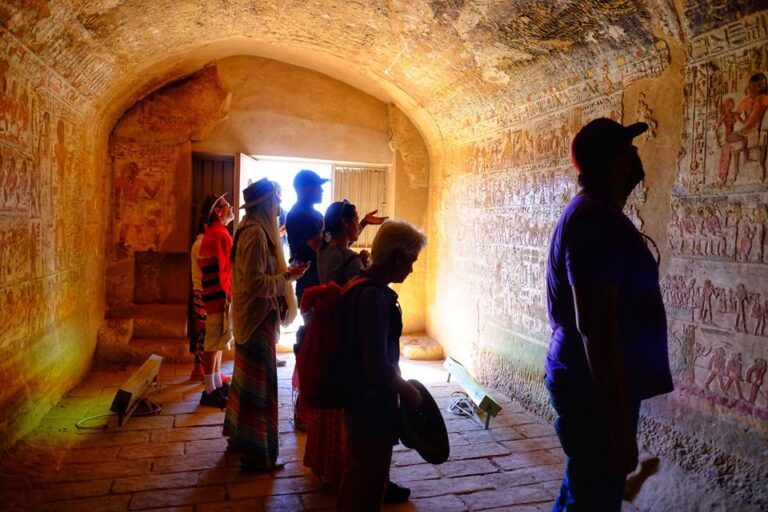
At El Kab, remains of ancient settlements date from about 3,000 BC (possibly centuries earlier) to Roman rule. The site is one of the most unique in Egypt because ancient villages and cities are rarely found. As we move inland, you will see the remains of the impressive mud brick walls and the long valley lined with tombs and shrines, including temples dedicated to Nekhbet and Thoth. We enter the decorated tombs of New Kingdom officials from the area.
We board the dahabiya for lunch and sail towards Edfu. Horse-drawn carriages take us to the imposing temple with its grand spaces and many hieroglyphic inscriptions. View Tell Edfu to the west of the temple, which includes houses dating from the Old to the New Kingdom. If time allows, we also stroll through the local market.
We sail again. From the boat, view a Roman fort. It is time to relax with dinner and drift into dreams as you are now becoming part of the rhythms of the Nile. Overnight, stay on board.
Day 6
Breakfast on board. Visit Bisaw Island and village, join the men in their boats to share the experience of Nile fishing, walk through farms and meet the villagers. Sailing to El Selsela ancient sandstone quarry and shrines. Special barbeque dinner by moonlight.
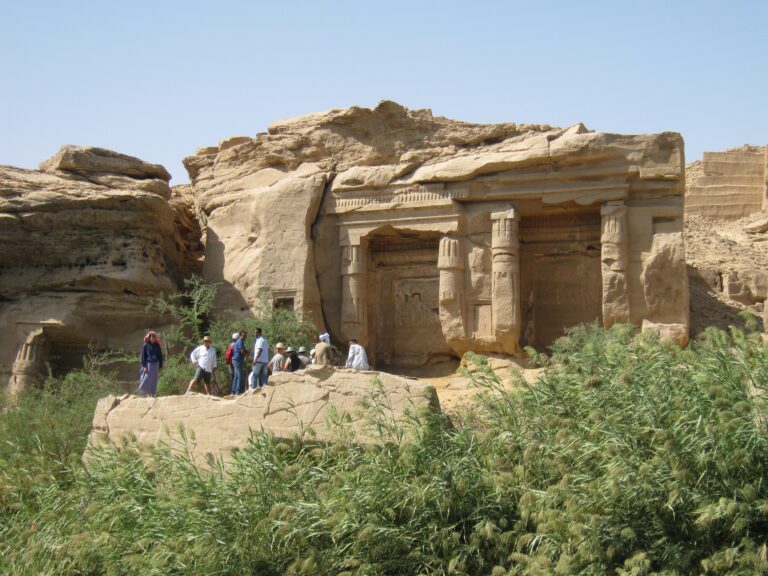
Breakfast in a local home in Bisaw village, where we take a leisurely walk through a farm, meet some of the women and children, and learn how the unique sun bread is baked in homes here. We are welcomed by the local fishermen to their boats, learning of the skills of these men who live in harmony with the Nile. Fish caught can be enjoyed as part of dinner that evening.
Lunch onboard and continue sailing to El Selsela, where we take a short walk parallel to the Nile to visit shrines and a massive quarry. Large amounts of sandstone were quarried here for temple buildings in Thebes (Luxor). Cut into the rock are the speos (chapel) of Horemheb, with its sanctuary containing rock shrines and various stelae and inscriptions. The huge quarry gives context to how much building material was sourced from this area. There is also an area of sand here where children (and children at heart) can slide and play.
Resume sailing until we reach a place for a special barbeque dinner by moonlight. Overnight, stay on board.
Day 7
Breakfast on board. Visit Kom Ombo temple and the Crocodile Museum. In the nearby town of Daraw you learn how to shop like a local at the market, visit a barn to meet camels and learn about the camel trade, and visit a Nubian Town. As we sail closer to Aswan if you wish there is an opportunity to swim or kayak. Farewell dinner and sail to our final destination Aswan.
Optional Tours:-

A short walk from the Dahabiya dock, the Temple of Kom Ombo is dedicated to the crocodile-featured god Sobek and the god Horus. The connection to the power of the Nile is unmistakable as you look towards the temple. We also visit the Crocodile Museum, which
includes some impressive mummified crocodiles.
In nearby Draw, explore a town that will give you a different sense of Egyptian life than what you see in the big cities. draw includes several Nubian communities. We will stop at a cafe to try a local beverage such as halfabar. We can plan our dinner for that night and learn how to shop, including a few words of Arabic, then try your new skills in the market shopping for ingredients for dinner. This is a fun opportunity to interact with the market traders. Ask your guide about shopping for other items too, including Arabic words
and prices. You will visit a barn for an introduction to camels, giving you some interaction with camels and the opportunity to learn about these fascinating animals and the camel trade. Note: If your tour visits Daraw on Saturday or Sunday, we visit the camel market instead of the camel barn. On Tuesdays, we can visit a livestock market.
As we near Aswan, you have the opportunity to swim or kayak. If you wish to kayak, please advise us two days before the Dahabiya tour begins so we can be sure to have kayaks available.
Sailing, lunch, dinner, and an overnight stay on board near Aswan
Day 8
Breakfast on board and check out of the Dahabiya.Travel to Abu Simbel. (3-4 hours’ drive along the desert) (Local Tour Guide in Abu Simbel) Visit Abu Simple temples. About 2 hours.Drive back to Aswan.Stop at the High Dam.Lunch.The tour duration is 9-10 hours. Check-in and rest. Evening, attend the sound and light show in Philae temple. If not available, will be replaced with a visit during the day. The tour duration is about 2 hours.Night stay in Aswan.

Check out Dahabiya. Travel to Abu Simbel by road and visit the temples. 280 kilometres (174 miles) south of Aswan and close to the border of Egypt and Sudan is the town of Abu Simbel. We travel here to visit two massive rock-cut temples, whose colossal statues on their facades are among the best-known images of ancient Egypt.
In 1968, the temples were moved from their original location to avoid being submerged due to the construction of the Aswan High Dam. They were moved 64 metres (210 feet) above and 180 metres (590.5 feet) west of their original site. Both temples were commissioned by Ramesses II. The second temple is dedicated to the goddess Hathor and Queen Nefertari, wife of Ramesses II. Abu Simbel was admitted as a UNESCO World Heritage Site in 1979.
Drive back to Aswan. On the way back, stop at the High Dam and enjoy views of the Old Aswan Dam and the Nubian Lake (Lake Nasser). Seeing the High Dam and lake adds to your understanding of how the changing flow of the Nile has influenced Egyptian history. The dam was built to control the flooding of the Nile, increase water storage for irrigation, and generate hydroelectricity. It was a controversial plan because the dam would flood the lands of the Nubian people and cover the remains of previous societies, including several important ancient Egyptian temples. However, the large area flooded caused the relocation of more than 100,000 people. Many archaeological sites were submerged.
inaugurated in 1070 Lunch. Check in at the hotel and rest. Evening, attend the sound and light show in Philae temple. If not available, it will be replaced with a visit during the day. During the 1960s, the monuments on this island were relocated from the original Philae island nearby so they would not be flooded because of the construction of the Aswan High Dam. Philae includes many structures, mostly dating to the Ptolemaic era (332–30 BC). The most prominent of these is a temple dedicated to Isis, begun by Ptolemy II Philadelphus. This temple was one of the last ancient Egyptian temples to remain active until Emperor Justinian I (527–565 AD). The temple was converted into a Christian church. Overnight stay in Aswan.
Day 9
Check out after breakfast. Visit the Unfinished Obelisk and Elephantine Archeological Site and the Nubian Village. Lunch. The tour duration is 3-4 hours. Transfer to Aswan airport and fly to Cairo. Transfer from Cairo airport to the hotel. Night stay in Cairo.
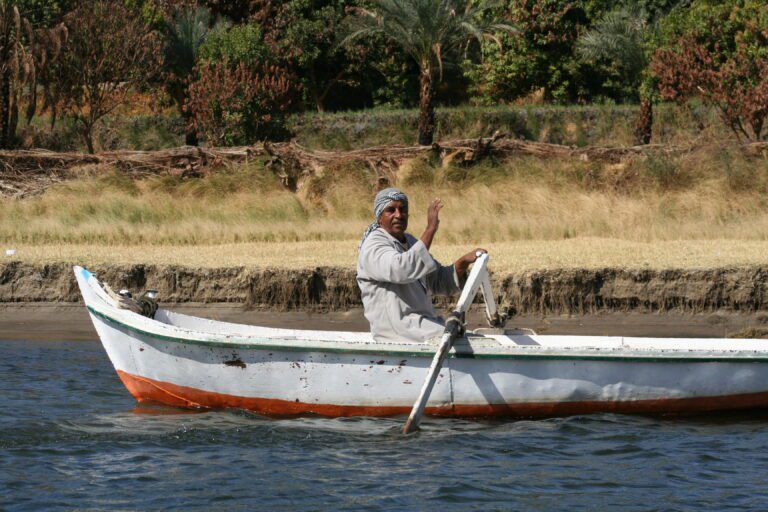
Visit the unfinished obelisk. Obelisks are four-sided, tapered monuments that were called tekhenu by the Ancient Egyptians. It is estimated that the unfinished obelisk would have measured 42 metres (138 feet) and weighed 1,089 t (1,200 tons), which would have made it the largest obelisk constructed by the ancient Egyptians. Felucca boat ride, viewing the Nobles’ tombs, the Agha Khan mausoleum, Plantation Island, and the Old Cataract hotel. Visit the Elephantine Island archaeological site. This is one of the most unique sites in upper Egypt because here you can see across 4,000 years of Egypt’s history, from 3,000 BC until late mediaeval times (12th to 14th centuries). We can also visit a Nubian village and visit the Animalia House Museum, which is an excellent place to learn about Nubian culture and the changes that came about with the building of the High Dam.
Lunch, then transfer to Aswan airport and fly to Cairo. Transfer from Cairo airport to the hotel,
overnight stay
Day 10
Visit the Citadel. Include Mohamed Ali mosque.Lunch at El Azhar park. A beautiful park in the center of Cairo, on the top of a hill overlooking the city.Walking tour in El Moez St, of Medieval Cairo. El Muizz St, is the most preserved area with medieval Islamic architecture such as Mosques, Houses, markets, and other Medieval architecture. It’s a perfect place to experience the local culture of Egypt today.Visit Khan El Khalili market.The tour duration 7-8 hours.
Optional tour:
Attend a folk show in Al–Ghouri Caravansary. According to the show schedule.
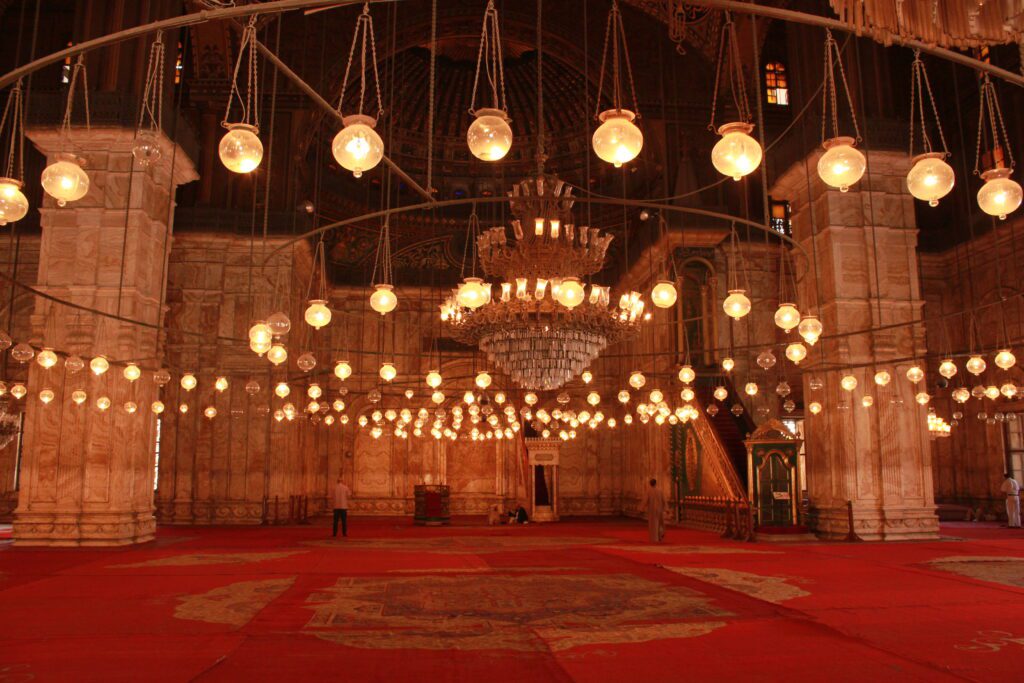
The Citadel was built to protect Cairo from the Crusaders; construction under Saladin began in 1176 AD. The impressive fortress includes museums, palaces, mosques, and terraces with
expansive views over Cairo. The rulers of Egypt lived here for about 700 years. The highlights are
the Mohamed Ali mosque, also known as the Alabaster mosque, built in 1830–1848 AD and including the tomb of Mohamed Ali, and the Al-Nasir Mohammed Mosque. We enjoy lunch at Al Azhar Park in the centre of Cairo, on top of a hill overlooking the city.
Walking tour in Al-Mu’izz Street, the area with the best preserved medieval Islamic architecture: mosques including Azhar mosque and university, madrasa (schools), houses with exquisite details, mausoleums, sabils (public fountains for drinking water), wikalas (caravanserai), Sufi monasteries, synagogues, and markets. Our visit to Khan el Khalili Market is a unique experience of walking through a bazaar that began its life in 1382 and continues its vibrant life in modern Egypt. It is an opportunity to see examples of many Egyptian crafts and Fishawy, a historic cafe.
| Quotation in USD - Per Person in a group of --- | 1 | 2 | 3 | 4 | 5 | 6 | 7 | 8 | 9 | 10 | 11 | 12 | 13 | 14 | 15 |
|
Airport transfers and assist as mentioned.
upgrade to suite is available when requested for an extra charge (subject to availability). For Christmas & Easter Periods: Supplement 120 USD Per Person in Double Room
|
1950 | 1613 | 1555 | 1484 | 1424 | 1380 | 1351 | 1330 | 1365 | 1347 | 1331 | 1319 | 1308 | 1299 | 1291 |
|
Accommodation per person in Double Breakfast and all taxes included.. Cairo : 3 Nights in Holiday Inn Maadi in Double Standard room Luxor : 1 night in Embrace in Double Superior room Aswan : 1 night in Artika Wadi Kiki in Double Deluxe Chalet or Similar according to availability, For Christams & Easter Periods: Supplement 65 USD Per Person in Double Room Rooms upgrades are available for an extra charge. Other hotels are available - ask for. Our accommodation prices are less than the online price. In case you found less price online, let us know to amend These prices might change when booking (notification will be sent to you)
|
475 | 475 | 475 | 475 | 475 | 475 | 265 | 475 | 475 | 475 | 475 | 475 | 475 | 475 | 475 |
| Grand Total per person in USD | 2425 | 2088 | 2030 | 1959 | 1899 | 1855 | 1826 | 1805 | 1840 | 1822 | 1806 | 1794 | 1783 | 1774 | 1766 |
| Single Supplement . USD | 1085 | 1085 | 1085 | 1085 | 1085 | 1085 | 1085 | 1085 | 1085 | 1085 | 1085 | 1085 | 1085 | 1085 | 1085 |
| Triple Deduction . USD | 119 | 119 | 119 | 119 | 119 | 119 | 119 | 119 | 119 | 119 | 119 | 119 | 119 | 119 | 119 |
|
Not Including:
|
|||||||||||||||
|
Notes:
|
© Dahabiya Nile Sailing Egypt 2024